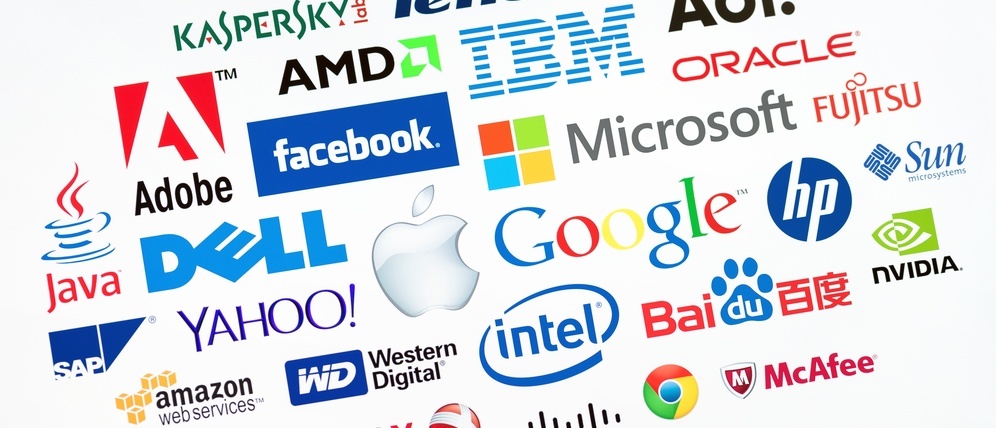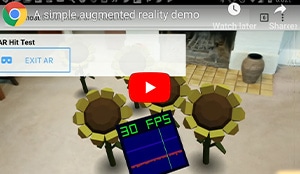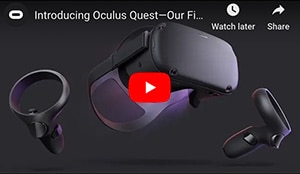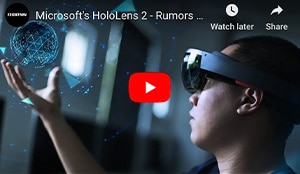
NOTE: Welcome to 3D Cloud’s (almost) annual predictions for the coming year. This isn’t the first time the 3D Cloud team has climbed out on the prediction limb, and you can check out some of our past prognostication here.The 2019 predictions discussion also exists as a podcast, which you can listen to here. And for an overview of what 3D Cloud does and for who, check out the Why 3D Cloud? page.
What Virtual Reality trends and Augmented Reality trends will be revealed in 2019?
2018 was a year of continued development for Virtual Reality and Augmented Reality. On the VR side, wireless was a major buzzword and a movement to cheaper, stand-alone HMDs was afoot. In the AR world, a wave of new apps hit Apple’s App Store and the Google Play Store, letting users do everything from measure distance without a tape measure to preview an entire new living room set right in their own home. As we enter 2019, the industry seems to have cooled a bit on Virtual Reality, which Augmented Reality is still touted as a “transformational platform” by heavyweights like Apple CEO Tim Cook.
So what trends does 2019 have in store for Virtual Reality and Augmented Reality? We asked 3D Cloud talented team of engineers, 3D Artists, marketing and account managers to help us suss out what the year ahead will hold. Here are their predictions for the top Virtual Reality and Augmented Reality technology trends for 2019.
1. Augmented Reality trends and predictions for 2019
Joe Johnson, Creative Director: 2019 will be a BIG year for Augmented Reality. AR will be more tightly integrated into smartphones than ever before, and will expand to more real-world uses beyond just games. AR will also benefit from an increased focus by the ‘Big Guys,’ who will spend 2019 neglecting VR to push AR applications harder than ever before. One big hurdle to adoption: Augmented Reality collaboration, since the only thing people really care about is communicating with each other anyway.
Dr. Ken Moser, PhD, Head of R&D: Google Chrome for mobile will be the first official release browser supporting WebAR. Once it’s launched, Apple will announce support for GLTF (in addition to its own USDZ format) in their QuickLook AR viewer.
Jon Jekeli, Product Engineer: The Augmented Reality technology that is already here becomes more and more available. We haven’t hit critical mass on Web AR, but we’ll see at least one company launch browser-based AR. No more downloading an app or special software required. Web-based AR will play with existing websites and change the way people get AR content. AR/VR slowly gather more adoption until someone makes a decent mobile AE/VR application and the technology takes off.
Leigh Davidson, UK Director: Harry Potter: Wizards Unite will drive record global AR usage in 2019 (Pokemon Go-style). Familiarity and confidence with the technology will drive an expectancy to see AR/3D in all parts of their everyday lives, like retail shopping.
Joe Bardi, Communications Director: 2019 is going to be a graveyard for AR hardware. Yes, we’ll probably see a brand new MicroSoft Hololens at some point in 2019 (perhaps as soon as January), but adoption will be limited to commercial applications like employee training, “visual instruction manuals” for repairs or assembling complex items, etc.
Vince Kilian, Product Development Lead, Project Technical Manager: The top 10 retailers across all verticals will have some kind of AR/VR support in store in 2019. Those that don’t will be looking at those that do with sad puppy dog eyes while watching their revenue going to their competitors.
Seth Cooper, Director of Analytics and Merchandising: Apple and Google launch updates to their respective development kits (ARKit and ARCore) that enhance features for Diminished Reality and floor plan measurement.
2. Virtual Reality Trends and Predictions for 2019
Joe B.: The hype cycle flips yet again! Conventional wisdom has become that AR is the usable tech, and VR is largely not ready for primetime. But the mid-year release of Oculus Quest changes that — Powerful, portable, and priced to sell at $399. By this time next year, VR will be the hot holiday gift and the “talking heads” will wonder why AR is squandering its lead?
Ryan Roche, UX Lead: There will be more guidelines/best practices for interface design for VR. Currently, VR applications have different looks and feels, and VR UX is the “wild west” right now, but more standardization will arrive in 2019. Designers actually creating and prototyping more of the experiences — moving away from desktop development and more in-VR development.
John “Skip” Petty, Technical Artist: The continuing trend of VR not being adopted into major, AAA gaming. There is a lot of tech advancement in GPUs, but there are clear lines of direction that indicate that VR games will not be a thing. SkippyBananas on Twitch.
Vince: VR will continue to be a powerful technology for people with disabilities, and will continue to improve things we already do by making them easier or more convenient. Case in point: By the end of 2019 you’ll see people virtually shopping grocery store aisles from their kitchen.
Seth: The first IRL retailer opens a VR shop on a gaming platform in digital world, selling both real furniture for real currency and VR furniture for “points” or whatever. As VR becomes even more mainstream, Big Box stores start adding it to their offerings.
Joe J.: We’re going to see the first cases of “VR Addiction” — people literally addicted to VR and spending as much time in-HMD as possible. Major drivers of this addiction? Dating simulators and VR travelogues, that make it possible to escape your shitty life like never before.
3. AR/VR hardware trends and predictions for 2019
Jeff Cowgill, Director of Software Development: Microsoft HoloLens 2 is coming out in 2019 and it’s going to be really good. Enterprise is the future for both AR/VR in 2019, because that’s who’s spending money and buying headsets, and enterprise will drive the AR/VR market for the foreseeable future.
Joe J.: On the HMD front, AR Smartglasses that a normal human being might actually wear and use will get developed near the end of 2019 and be commercially available, though no interesting software will exist for them. A half-decent standalone VR headset will also be released in 2019, but it won’t matter, because you can’t see what you’re doing outside the HMD, turning off users. Companies can make their workers use VR HMDs though, so training programs will see a decent bump in adoption.
Joe B.: No Apple HMD in 2019. Why? No new iPhone design in 2019. Apple will try and squeeze one more year out of the iPhone design that debuted with 2017’s iPhone X. But in 2020, Apple’s “A14 Quadronic” (or whatever they decide to call it) and 5G adoption will make it possible for the Big Fruit to launch a pair of smartglasses that wirelessly tethers to the iPhone.
Leigh: A new round of Google Glass hype. AR glasses for the mainstream, Apple/FB/Snap/MSFT/Google/ML…someone else!? Scary and Exciting times for retail as everyone scrambles for 3D assets and 3D Cloud!
Seth: Amazon gets on the consumer VR/AR device train by launching a phone/device/development kit with a massive content library. Other companies (HTC, Oculus, Etc.) launch small, wireless, self-contained headsets and we soon have VR zombies roaming the streets (as opposed to cell phone zombies that we see now).
Dr. Ken: HTC Vive will go station-less and wireless (without attachment). Apple will announce a wearable headset.
4. Augmented Reality and Virtual Reality company predictions for 2019

Dr. Ken: Google will care less and less about its Android user-base, and will push for more Apple-style premium offerings.
Joe B.: Facebook will try to get into AR hardware, a la Snap, and fail miserably. The public rejection of the product, and of the social network in general due to privacy concerns, will lead to Mark Zuckerberg’s ouster as CEO by the end of the year.
Jeff C.: Magic Leap will spend their enormous cash hoard staying afloat in 2019, and then fail in 2020. Why? Their device is basically equal to the original HoloLens, which is older and about to be replaced by an upgrade.
Seth: Wayfair goes broke(r) when Augmented Reality doesn’t save them.
Ken: Wayfair continues to lose money, and finally figures out that it isn’t that good at what it does. Oculus will continue to fall into obscurity, with Facebook maybe even considering selling it off. Magic Leap will downsize, while the HoloLens 2 doesn’t fare much better in the market than HoloLens 1. Windows stops its Mixed Reality push.
Carissa Mastry, Account Manager: Lil’ Bob, the mascot of Bob’s Discount Furniture, finally makes his AR & VR debut as a 3D model and inspires a fun, aspirational group of folks in the Northeast.
5. Other Predictions for 2019
Carissa: AR and VR will become the most popular choice for interior designers and drive 75%+ of consumer purchase behavior in-store and at home.
Seth: Or another version….several people get pulled over and ticketed for wearing VR headset while “driving” in an automated car.
Joe J: Since gaming seems to be the primary way the general public is using VR HMDs, it seems likely that the arcade makes a comeback as a new location-based entertainment since VR setups need some space to work out.
Leigh: There will be more and more retailer investments in 3D AR VR (projects, teams, visions) as they shift their thinking from innovation play to must have 3D solutions
Joe B: Live VR broadcasts will become a thing, with the LA Lakers playing the Golden State Warriors live in VR on Christmas Day. Millions will tune in to watch LeBron duke it out with Steph on the new Oculus Quest HMDs they just unwrapped that morning.
Dr. Ken: By end of 2019, a notable percentage of Americans will have shopped for or purchased furniture through AR/VR powered by Marxent. Oh, and civilization will end as a result of an unspecified “global annihilation.”
Note: Ken predicts this global annihilation every year, so maybe don’t panic just yet.














